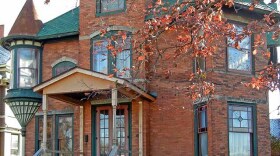Retired Western Michigan University professor of art Charles Stroh spent five years putting together six walking tours of Kalamazoo’s architecture. He gathered information for the tours from his year-long column with the Kalamazoo Gazette called Hidden Kalamazoo and extra credit assignments from his old classes. You can pick up Charles Stroh’s CD on Kalamazoo architecture at Petals and Postings, Bella Patina, Retro, and through Stroh himself.
To get an idea of what you'll find on the CD, Stroh took me inside two places in the city with a lot of history—starting with the First Congregational Church on Michigan Avenue.
“It’s one of three churches that burned in the 1920s and there’s still some mystery about exactly what happened,” says Stroh.
After sorting through the ruins, First Congregational, First United Methodist, and First Presbyterian were all rebuilt in the English Gothic style. A medieval look that’s known for pointed archways and round, vaulted ceilings. First Congregational Church has a groin vaulted ceiling—that’s right groin vaulted. That just means that the two round vaults meet at a point or groin. It basically looks like someone cut triangles out of the round ceiling to place the windows.
“That area that’s inset where the window is happens to be right between—on the exterior of the building—two gargoyles that stick out from the side of the church,” Stroh explains.
In the middle of the ceiling, there are narratives painted in a line. Over the pulpit, there’s a re-creation of The Last Supper where each apostle’s face is different.
“Which is kind of unusual because somebody who painted that took the time to think of the participants in that event as people, you know, rather than sort of symbols of something,” says Stroh.
Probably the most interesting thing about the church is a glass window that doesn’t have much to do with religion at all. The window shows historical figures from science, art, and literature.
“There’s Shakespeare, there’s Erasmus, there’s Michelangelo on the left side,” Stroh explains. “And on the right there’s Lincoln, Newton. Again, people you wouldn’t normally associate with the Christian tradition.”
Kalamazoo's city hall also has a rich architectural history. Stroh says the city commission's chamber hasn’t changed since it was built in 1931 in the art deco style. The style is all about repeating shapes, patterns, and colors.
“And if you look at the ceiling, especially on the edges of the ceiling, you’ll find repetitions of those floral patterns all the way along with shells—seashells--inserted every here and there," say Stroh. "Birds inserted every here and there. A sun that has a face in the middle of it.”
Art deco fans also liked to put rich materials next to each other to make the place look expensive.
“Like a particular kind of marble you might only find in South Africa, for example, would be used next to a kind of mahogany that you would only find in the Philippines and no where else,” Stroh says.
With all of this luxury, Stroh says you’d never believe city hall was built during the Depression.
“Pretty amazing that this would get done at a time when there was 25 percent unemployment and people were having a hard time,” he says.
Stroh says the architecture in Kalamazoo is like other cities of its size, but what makes it special is that it belongs to the people of Kalamazoo.
“Every day of their lives going to work, they’re aware that that building is over there and they see it out of the corner of their eye," he says. "But oftentimes they don’t ever look at it. And hopefully something like the CD at least would suggest, ‘Now here’s a detail of something that came from that building. And next time you go by, stop and look at that.”











